Examples Reservoir Characteristics Eolian Environments
Eolian environments have been identified as significant petroleum reservoirs in various regions across the globe. Here are a few notable case studies:
The Rotliegendes (Lower Permian) group of the southern North Sea basin contains a series of giant natural gas fields, including the onshore Groningen field (Netherlands), and the offshore West Sole, Viking, Leman, and Indefatigable fields. (Figure 1, Location of the Viking gas field area in the southern North Sea region.) Proved and probable reserves combined for this play are on the order of 85 tcf.
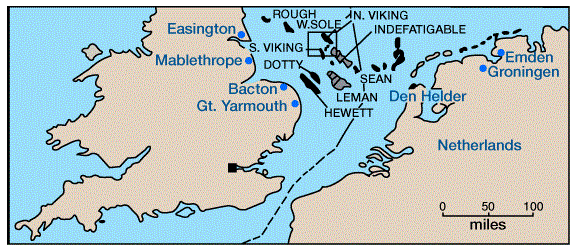
Though the Rotliegendes itself contains a diversity of continental deposits (including fanglomeratic sands, braided stream/wadi conglomerates, playa/sabkha silts and shales), the most favorable reservoir is decidedly the eolian Leman sandstone.
In this region of northwestern Europe, the Late Paleozoic saw the development of an orogenic belt that stretched from what is today southern Ireland, across southern England and the low countries into Germany. An arid climatic region existed at that time and a suite of desert facies, including alluvial fan, braided stream, eolian dune, coastal sabkha, and evaporitic marine environments, developed from the rising highlands northwards into a subsiding southern North Sea basin. (Figure 2, Distribution of environments and facies in the Rotliegendes group.
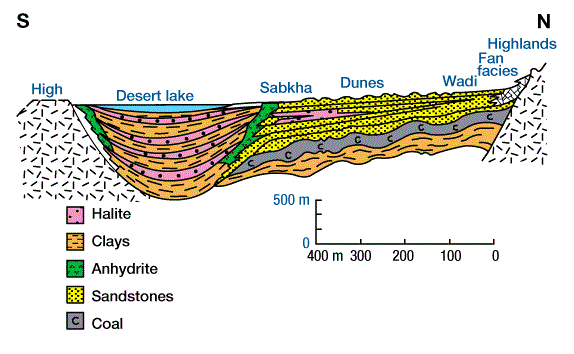
See Figure 3, A schematic cross section through the Trucial coast of Oman, for comparison).
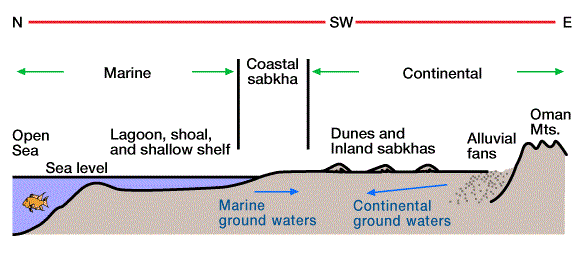
The basin was bounded to the north by a low ridge, now called the mid-North Sea high. Prior to basin subsidence, the region had undergone a period of erosion, which truncated gently folded Pennsylvanian Coal Measures. These were buried by the Rotliengendes redbeds which, in turn, were overlain and “sealed” by the carbonates and evaporites of the Upper Permian Zechstein when the ocean breached the mid-North Sea high. Subsequent tectonism broke up the basin floor into horsts and grabens, and the increased pressure/temperature conditions associated with this movement helped generate gas in the buried coals. The Rotliegendes were thus in an ideal position to act as reservoirs for this gas.
As shown in Figure 4, (Map view of the facies progression shown in Figure 2 as interpreted for the Viking gas field are),

three main facies characterize the Rotliegendes of the producing area. These were identified largely on the basis of core samples (Gage 1980), which served as a basic guide for log analysis. Along the southern flank of the basin adjacent to the mountain front are red conglomerates and coarse, pebbly, poorly sorted, crossbedded sands, interpreted as the remains of a braided wadi outwash plain, with the most proximal, fanglomeratic facies believed to indicate fan deposition.
Due to poor sorting, this facies has low to negligible reservoir quality. It was deposited by a series of ephemeral rivers flowing from west to east, out of the highland area and through a region of eolian dunes. These fluvial deposits inferfinger to the north and south with medium to fine-grained, well-sorted sands which, as shown by core and dipmeter work, contain giant-scale, concave-upward crossbeds 50 ft high or more. Logs through this facies are very similar to that shown in Figure 5.
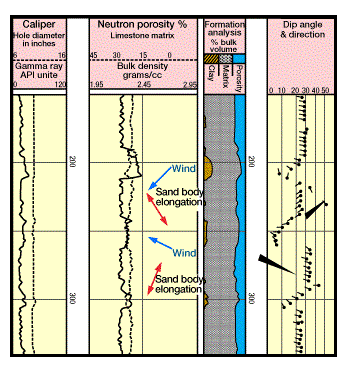
(Log motifs for eolian sands. Note the well-developed blue pattern of upward-increasing dips along the toeset-foreset transition in individual dune units.) This dominantly eolian facies grades northwards into red shales and evaporites, which suggest deposition in playa lake and sabkha environments. Grain sorting appears to be the main factor affecting reservoir quality in all facies.
Rotliegendes reservoir characteristics are, as indicated, directly tied to facies. (Figure 6,
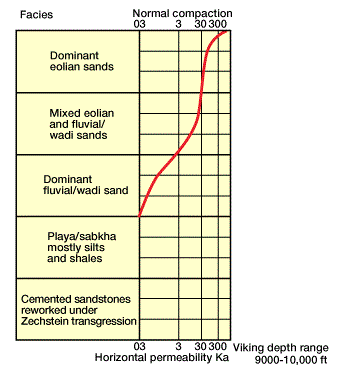
Overall relationships between facies and permeability, Rotliegendes Group, Viking gas field area and Figure 7, Porosity/permeability plot for the various facies in the Viking gas field area).
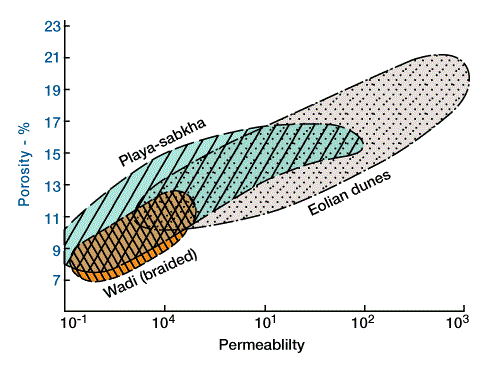
Their variability necessitated detailed mapping of basin paleogeography in stages. These maps were able to show how a series of specific alluvial fans prograded northwards towards an enormous playa lake. The sediments of these fans were winnowed out and reworked by desert winds which then redeposited them in well-sorted form as a surrounding field of dunes.
Such mapping was not done simply to reconstruct picturesque deserts of the past. In the case of the Rotliegendes, it was able to not only explain, but to predict reservoir heterogeneities, thicknesses, and lateral extent. This example further reveals that not all braided stream deposits are alike; they do not universally possess high reservoir quality. Facies analysis, then, is most often just the beginning to cogent, useful knowledge about a particular basin or formation.
Other Case Studies
Rub’ al Khali, Saudi Arabia
The Rub’ al Khali, also known as the Empty Quarter, in Saudi Arabia is a vast desert characterized by extensive eolian sand dunes. This region has been extensively explored for hydrocarbons and is home to several eolian reservoirs. The Arab-D reservoir, a eolian sandstone unit, has demonstrated excellent reservoir quality and significant oil and gas accumulations. The understanding of eolian sedimentology and reservoir characterization in the Rub’ al Khali has contributed to successful exploration and production activities in this challenging desert environment.
Permian Basin, United States
The Permian Basin in West Texas and Southeastern New Mexico is renowned for its diverse range of hydrocarbon reservoirs. Eolian depositional systems play a crucial role in this prolific petroleum province. The eolian sandstones of the Yeso Formation and the Clear Fork Formation are key reservoir units. These formations exhibit high-quality reservoir characteristics, including good porosity, permeability, and hydrocarbon saturation. The study of eolian reservoirs in the Permian Basin has led to significant discoveries and successful production operations.
Namib Desert, Namibia
The Namib Desert in southwestern Africa is characterized by extensive coastal eolian systems. The eolian sandstones in this region, such as those within the Kuiseb Formation, have shown potential as reservoirs for both oil and gas. The sedimentary structures and cross-bedding patterns in these eolian deposits have been instrumental in understanding reservoir connectivity and optimizing production techniques. The unique challenges posed by the arid environment and the complex dune systems of the Namib Desert necessitate innovative approaches for exploring and producing hydrocarbons.
Tarim Basin, China
The Tarim Basin in northwestern China is a large sedimentary basin with diverse depositional environments. Eolian deposits within the basin, particularly in the Ordovician and Carboniferous formations, have demonstrated significant hydrocarbon potential. These eolian reservoirs exhibit varying degrees of porosity and permeability, influenced by grain size distribution and diagenetic processes. Successful exploration and development of eolian reservoirs in the Tarim Basin have contributed to China’s domestic energy production.
These case studies highlight the global significance of eolian environments as petroleum reservoirs. The understanding of eolian sedimentology, reservoir characteristics, and exploration techniques in these diverse regions has led to successful hydrocarbon discoveries and production operations. The continued research and application of eolian reservoir knowledge contribute to the advancement of petroleum geology and the sustainable development of hydrocarbon resources.
 Petro Shine The Place for Oil and Gas Professionals.
Petro Shine The Place for Oil and Gas Professionals.



